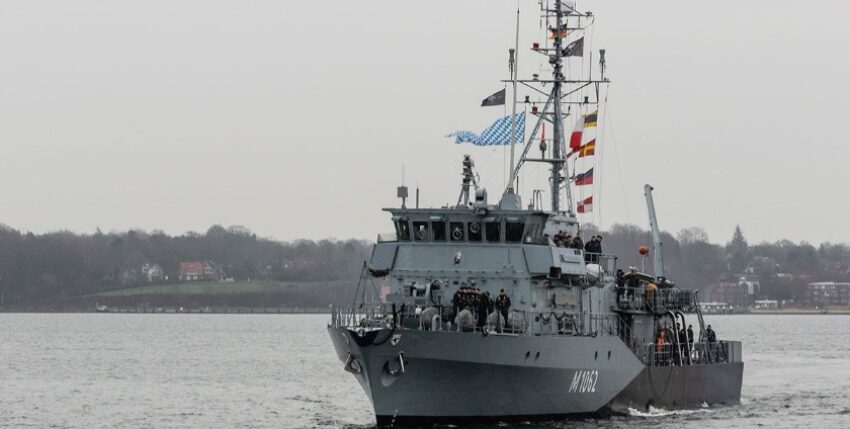In turbulent times, the German Navy has all the necessary capabilities to play a leading role in the Baltic Sea area.
The Baltic Sea has never really been a "sea of peace"! Even the Hanseatic League fought here for the freedom of the seas and safe sea routes. During the world wars, the Baltic Sea was both a battlefield and an escape route, and during the Cold War it was both a deployment zone and the front line of the power blocs. To this day, it is an involuntary repository for the legacy of the world wars and at the same time an important trade route for the neighbouring countries and international shipping. The extent and quality of the critical infrastructure on the seabed there has steadily increased. In terms of energy supply and communication, the Baltic Sea is therefore now of strategic importance.
Following the dissolution of the Warsaw Pact, the cumulative coastline of the local NATO partners has increased from 7,100 to 11,000 kilometres due to the accession of new members. Following the planned accession of Sweden and Finland to the Community, this will increase significantly once again. There would then only be one neighbouring country that is not a NATO member: Russia. Its access to the Baltic Sea is limited to two relatively small sea areas off St. Petersburg and off the enclave of Kaliningrad, each around 250 kilometres wide.
Will the Baltic Sea become the "Sea of Peace" after accession because it is almost entirely surrounded by NATO states and the alliance threatens no one?
Can Russia's actually unfavourable strategic position in the Baltic Sea displace its colonial claims on neighbouring countries - especially the Baltic states? Certainly not!
If NATO territory is attacked by Russia, the Baltic Sea is a defence and deployment area for the alliance, and perhaps also a base for supporting land operations. This includes the protection of the coasts and critical infrastructure, the necessary sealing off of the two Russian naval harbours and, above all, the securing of maritime transport routes.
Taking responsibility
In all conceivable scenarios, the German Navy is of particular importance due to its combat and command capability. As the largest NATO navy in the Baltic Sea, it can assume a regional leadership role and provide the corresponding forces. NATO knows that the German Navy can assume this responsibility once a Regional Maritime Headquarters for the Baltic has been established.
But what capabilities are required for the permanent protection of NATO's Baltic Sea neighbours and secure international maritime traffic? The presence of surface units to protect the sea lanes and to defend against enemy attacks by sea and from the air is a central task of the NATO navies. This also includes the support of land units. A permanent presence alone never fails to have an effect on a potential enemy. The departure of all available units of the German Navy to the Baltic Sea after the Russian attack on Ukraine was viewed with great respect by friend and foe alike.
Effective maritime surveillance requires a sufficient number of suitable platforms. Maritime surveillance must take into account the critical underwater infrastructure, which also requires specialised forces and appropriate procedures for effective protection.
The ability to defend against a large landing force as far east as possible and as simultaneously as possible on, under and above the water was the core of operational planning during the Cold War and can certainly no longer be planned in this form. Nevertheless, naval warfare from the air and defence against enemy air forces must of course be included in multinational maritime operational planning.
The use of mines should be considered in order to seal off enemy harbours and protect one's own coasts. Against the background of the new geostrategic situation - particularly in view of Sweden and Finland joining NATO - the sealing off of access to the Baltic Sea has been pushed into the background. While the protective use of mines on one's own coasts to protect against landings is possible at any time, an offensive use of mines or a defensive use of mines in international waters can be optional, but requires a political decision because both variants represent active acts of war.
An essential cornerstone for the development and further development of operational plans is effective, permanent and comprehensive reconnaissance even in peacetime.
The capabilities mentioned certainly still need to be supplemented. Nevertheless, they are part of the "standard repertoire" of the German Navy. It also has a state-of-the-art command centre in Deu Marfor. So who would be better suited to protect the "Sea of Peace" and its neighbours in a leading position?
Former frigate captain Ottmar Becher is Editor Yellow Pages and Marineforum Online.
Ottmar Becher









One Response
As in the article Quo vadis, Marine? from the May issue of Marineforum, one component no longer appears when considering the Baltic Sea and the North Flank area: the flying component. Finland and Sweden are two countries on board when it comes to future considerations of naval warfare from the air. Who should lead them? The same question applies to the northern flank area.